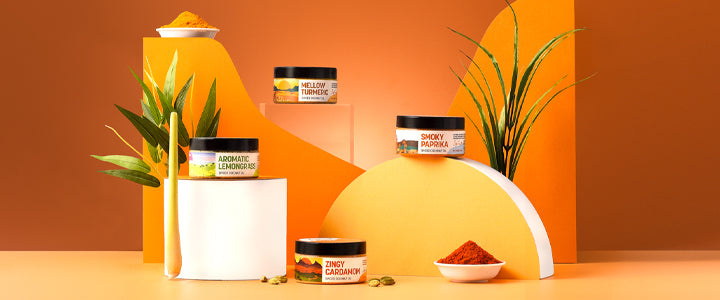Turmeric

Turmeric is a spice that has been used for centuries in cooking and traditional medicine. This blog post will explore the history and health benefits of the turmeric spice, as well as how to add it to your diet!
Though less known in the western world, Turmeric has a long history of use. It was first mentioned in ancient Sanskrit texts from India around 3000BC. It has been used for culinary purposes and medicine since then. More recently, it has caught the attention of scientists, physicians and nutritionists because of its unique health benefits.
Turmeric is most commonly known for its characteristic deep yellow to orange-yellow powder colour, but it can also be found in fresh form or dried roots.
Turmeric is a flowering plant, Curcuma longa, of the ginger family. It is also known as tur ra and spans several countries in Asia. The rhizomes from this herbaceous species grow best at around 20-30 degrees Celsius (68 °F), where they require ample rainfall per year to stay healthy. It is possible to achieve homegrown Turmeric in the UK with the right conditions.
It is an important ingredient of many South Asian, Middle Eastern and Southeast Asian cuisines.
Turmeric contains a group of chemical compounds called curcuminoids which are the primary source of its health benefits. However, these compounds are not water-soluble, so they cannot be absorbed in the body from ingestion alone without being converted into a water-soluble form using heat (for example, cooking).
Curcuminoids have been shown to provide anti-inflammatory, antibacterial, antiviral and antioxidant effects, among others, due to their ability to inhibit specific processes within cells that can lead to disease.
There are several studies available that show black pepper increases the absorption of Turmeric. Black Pepper contains an active ingredient called piperine which helps break down nutrients in food, allowing them to be absorbed more easily by your body when eaten alongside other foods.
The current pandemic crisis has brought Turmeric back to the forefront due to its antiviral properties and possible benefit to help prevent contraction of COVID-19, in addition to helping patients infected with the virus.
In 2018, Mathew & Hsu conducted a review of Curcumin studies and concluded its capability to target cellular pathways to prohibit the growth and replication of viruses makes it a potential candidate as an antiviral drug.
You should always seek medical advice if you have any health concerns.
Great ways to get Turmeric into your diet:
Golden milk Latte or Chai Golden Latte:
Great for calling, lifting your mood, and the combination of Turmeric, ginger & cinnamon are loaded with antioxidants
Golden Milk Latte Recipe:
Bring 500ml of milk or plant-based milk to a boil with 1 tsp powdered Turmeric and 1 tsp powder or freshly grated ginger. Let cool for a few minutes, and add 1 tbsp of raw honey. You can add 1/2 tsp of nutmeg, cinnamon and cardamom to help with a good night’s sleep.
Chai Golden Latte Recipe:
Bring to boil 250ml water, two black tea bags, 2tsp Turmeric, 1tbsp fresh ginger, 2 tbsp Maple syrup, 5 whole cloves, 6 whole black peppercorns, 2 whole cardamom pods, whole nutmeg 500ml mail, dairy or plant-based. Once boiled, leave to infuse for at least 5 minutes—strain before serving.
Turmeric tea.
Mix 2 teaspoons of powdered Turmeric in 500ml boiling water, +1 tbsp of raw honey, juice of 1/4 lemon +grated skin, and a sprinkle of black pepper.
Smoothie
Instantly boost the Turmeric benefits but adding a teaspoon to your smoothie.
Soups
Instantly boost the Turmeric benefits but adding a tablespoon to your warmed soup.
Some Great Turmeric Recipes
Turmeric is the main spice ingredient in the Mellow Turmeric Coconut Cooking Oil which is the oil used in several of the Zing Foods recipes.
Follow this link to check out the Zing Foods Recipe Page



Comments